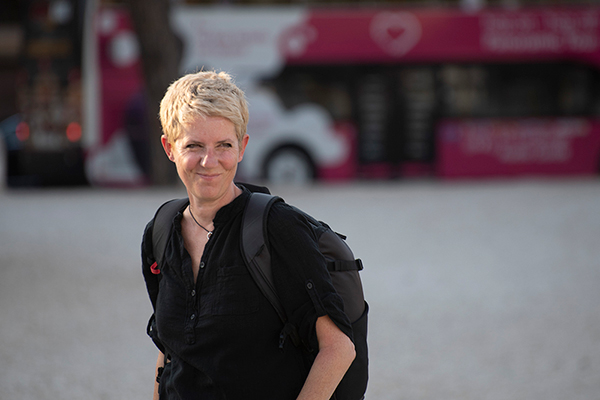Born in Rome in 1968, after an initial artistic training, Claudia Tombini studied Architecture at La Sapienza University. After graduating, she followed a PhD in Architecture - Theories and Design at the DIAR department of the same University. Professionally active in her hometown since 2006, she carries out her work independently after a three-year collective experience with studio A4, winner of several mentions and awards. Specialized in architectural design, she has always combined research and design. Her latest work is the restoration of the Troisi Cinema in Trastevere. In 2016 she began her own photographic research, collaborating in some of Officine Fotografiche's activities. In 2019/20 she participates in "Human" curatorial workshop with Luigi Cecconi and Francesco Rombaldi, from Yogurt Magazine, during which she elaborates her own project MoveTo LineTo.
Moveto Lineto
"'Living is an art of spacing,' as Jean-Marc Besse teaches us, and living is mainly a question of geography. After a lifelong dedication to architecture I now discover, thanks to these words, that living is not about architecture or city planning, nor, more generally, about construction: living is geography.
There is a human sense to architecture, which even preexists architecture, as we actually live our lives outside of it, in an unbroken series of passages, intersections, and places which all leave their own special resonance and memory inside us. As I move through these, without ever pausing in the gaps — sometimes more, sometimes less consciously — I find myself measuring out the distances I have covered. Not in terms of space, though, as when it comes to landscapes distance is actually temporal, and measuring it out in its complexity is no easy task. As Matteo Meschiari has said, what I am after is “an altered state of conscience in which the landscape is simultaneously medium and recipient, cause and effect, reactor and reaction”: it is a matter of sensorial dilation.
I gaze back on these landscapes, “before” and “after”, I scrutinize them to reproduce them virtually, searching for the same old viewpoints, as if they were light years away. This is the effect any catastrophic event will have on us, namely making us believe that all linearity is forever lost, as if time actually flowed in a linear way. Knowledge will not do, knowing that history is all but linear is not enough: we won’t give up our linear idea of it, and we will feel lost when confronted with any interruption of it, with any interval, any blank gap, no matter how temporary.
I have been ceaselessly trying to heal the wounds that the surface of things displays, because it is on the surface that we move, it is the surface we perceive, with its naked spaces, where only the absence or the lost track of what has happened is visible. Indeed, any figuration registers an appearance that is destined to vanish, and it is through imagination that we manage to value what is actually not there. It is through the abstraction of a virtual image, an image never completely resolved in its structure and its appearance, that I have been trying to turn the image itself into matter, and thereby restore to it a potential wholeness that I feel is unattainable to me today. This new matter will do, for the time being, to represent the times and places of our passages, and the gaps in between. Like a postscript file, it will be readable in its own right, by its own definition. " -- Claudia Tombini
